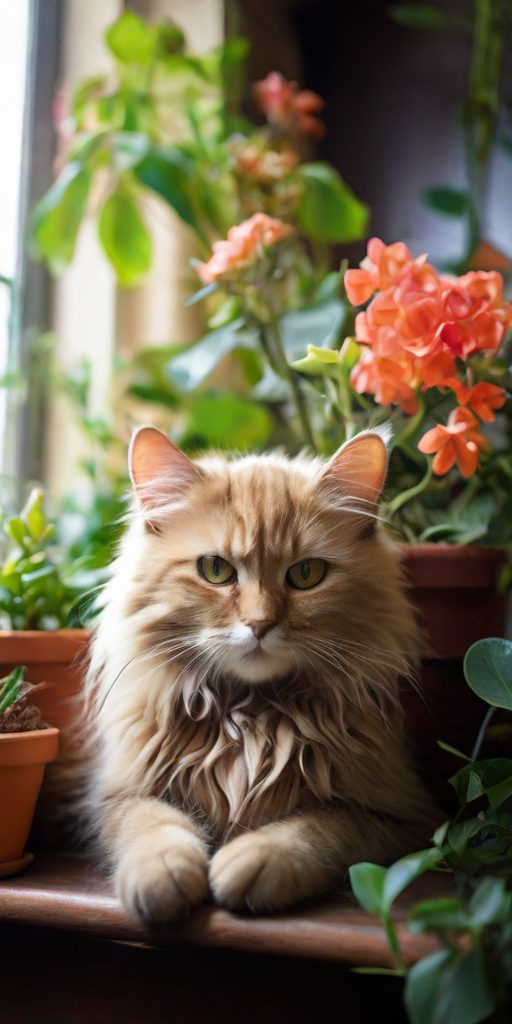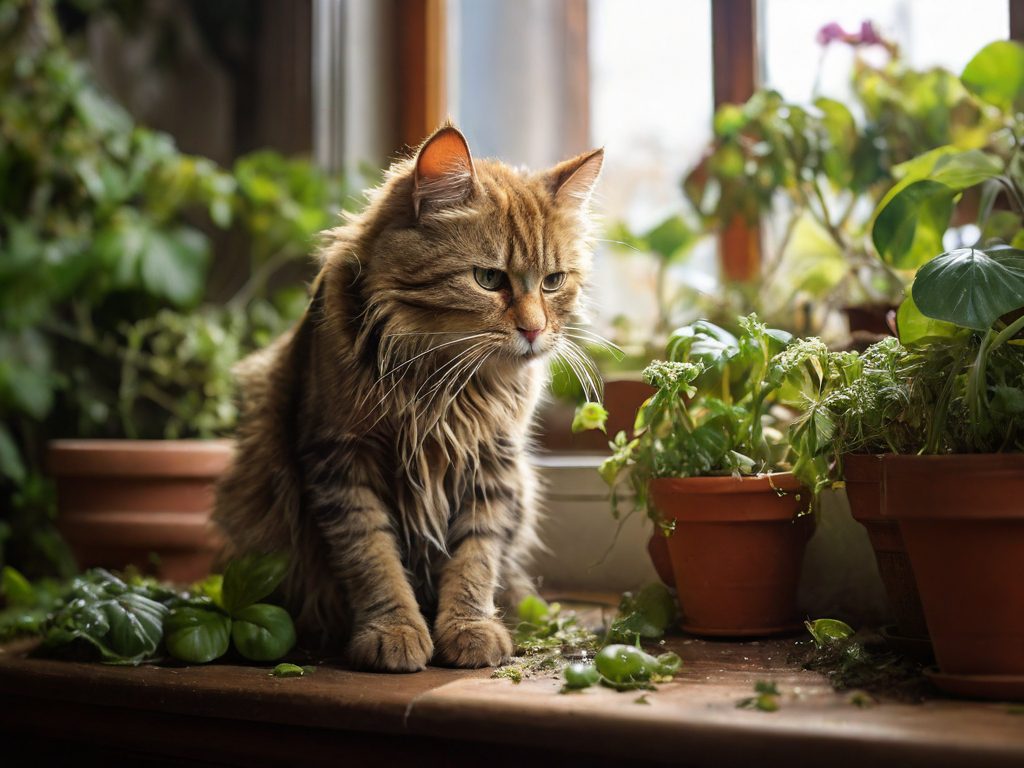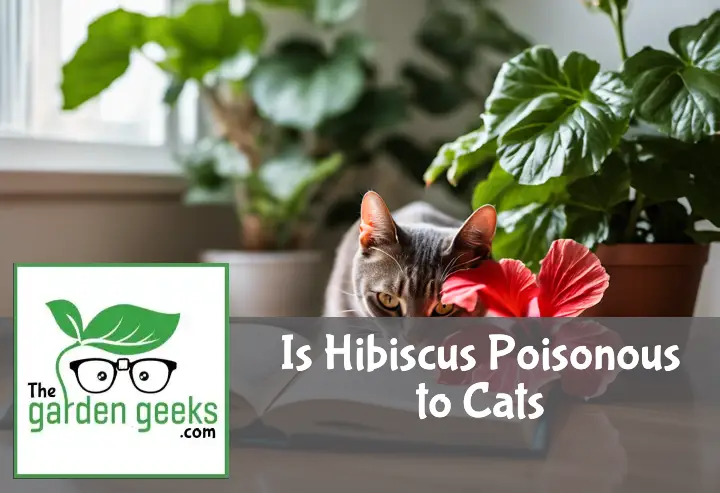Hey there, fellow cat parents! Ever caught your feline friend sniffing around your hibiscus plant and wondered, Is Hibiscus Poisonous to Cats? Well, you’re not alone. Many of us have been in that spot, scratching our heads and frantically Googling for answers.
But worry no more! We’ve got the lowdown on this tropical temptation and other houseplants. So stick around as we dive into the verdant world of cats and plants. Keep reading …
Key Takeaways
- Hibiscus plants are not safe for cats. While they’re not deadly, ingestion can lead to uncomfortable symptoms like vomiting and diarrhea.
- Cats are often attracted to houseplants, including hibiscus, due to their natural instincts. It’s important to keep an eye on your feline friends around any greenery.
- There are plenty of cat-safe houseplants you can opt for instead, such as spider plants or Boston ferns. Do some research before bringing a new plant into a cat-filled home!
- Certain plants like lilies and oleander are extremely dangerous for cats, potentially causing severe health issues or even death.
- If your cat has ingested a toxic plant, look out for signs of plant poisoning such as drooling, loss of appetite, difficulty breathing, or changes in behavior.
- Contact your vet immediately if you suspect that your cat has ingested a toxic plant. Don’t try to induce vomiting unless instructed by a professional.

Why Cats Are Attracted to Hibiscus Plants
Many cat owners have noticed their cats attracted to hibiscus and other houseplants. But why is this?
First off, cats are naturally curious creatures. They love exploring new things, and a hibiscus plant with its vibrant colors and interesting textures is just too tempting for them to ignore. This feline behavior towards plants is part of their natural instincts.
Secondly, cats are carnivores but they do sometimes eat plants. It’s a bit of a mystery as to why do cats eat plants, but some experts believe it could be due to dietary needs or simply because they enjoy the texture.
Understanding this cat-plant interaction can help you create a more pet-safe indoor gardening environment. If your cat seems particularly drawn to your hibiscus plant, consider getting some cat-friendly houseplants instead that won’t harm them if ingested.
Lastly, remember that prevention is better than cure! There are ways to prevent cats from eating plants, like providing them with cat grass or distracting them with toys.
Top 10 Cat-Safe Alternative Houseplants
There’s a wide variety of non-toxic houseplants for cats that you can choose from.
- Spider Plant (Chlorophytum comosum): Topping our list is the resilient and charming Spider Plant. Known for its long, arching leaves that sport a unique variegation, this plant is a favorite among cat owners for its non-toxicity and ease of care. Not only does it bring a touch of nature into your home, but it also thrives in a variety of lighting conditions and can improve indoor air quality. Its spiderettes (baby spider plants) dangling from the mother plant create an engaging visual effect while being completely safe if your cat gets a little curious.
- Areca Palm (Dypsis lutescens): The Areca Palm is a lush, tropical plant that not only brightens any room but also acts as a natural air purifier. Its long, feather-like fronds are non-toxic and provide a safe, jungle-like atmosphere for your curious cat to explore. This plant prefers bright, indirect light and regular watering, making it a delightful addition for both novice and experienced plant owners who also happen to be cat lovers.
- Boston Fern (Nephrolepis exaltata): Another excellent choice for cat-friendly households is the Boston Fern. This plant features graceful, arching fronds that are perfect for adding a touch of greenery to your home. The Boston Fern is known for its air-purifying properties and its ability to thrive in a humid environment, making it a great plant for bathrooms or kitchens. Plus, its soft fronds are safe for cats who like to brush against or play with them.
- Haworthia: If you’re a succulent enthusiast, Haworthia is an ideal pick. This small, robust plant is distinguished by its rosette-shaped, fleshy leaves that come in a variety of patterns and colors. Haworthias are particularly appealing for busy cat owners, as they require minimal care and are completely safe for cats. These succulents prefer indirect light and infrequent watering, making them a fuss-free addition to your collection of safe houseplants.
- Money Tree (Pachira aquatica): Rounding out our list is the Money Tree, a plant heralded for its braided trunk and vibrant, green leaves. Beyond its aesthetic appeal and supposed financial luck-bringing properties, the Money Tree is safe for cats and simple to care for. It prefers moderate to bright indirect light and requires watering only when the top few inches of soil are dry.
- African Violet (Saintpaulia): Known for its vibrant blooms and fuzzy leaves, the African Violet is a superb choice for adding a splash of color to your cat-friendly plant collection. These delightful plants thrive in indirect sunlight and prefer their soil to be slightly moist. African Violets are non-toxic to cats, making them a worry-free option for adding a floral touch to your home.
- Parlor Palm (Chamaedorea elegans): Add a bit of elegance to your living space with the Parlor Palm. This graceful, pet-safe plant brings a soft, tropical feel to any room without posing a risk to your feline friends. It’s well-suited for indoor environments, thriving in low light and requiring minimal watering, making it perfect for busy pet owners.
- Cast Iron Plant (Aspidistra elatior): As the name suggests, the Cast Iron Plant is tough and nearly indestructible, making it an excellent choice for cat owners. Its long, dark green leaves provide a striking aesthetic without requiring much light or water, ideal for those darker corners of your home. Plus, it’s completely safe for your curious cats.
- Calathea (Calathea spp.): The Calathea, with its beautifully patterned leaves, is a stunning plant that is safe for cats. It is known for its unique leaf movements, as they open and close from day to night. Calatheas prefer indirect light and high humidity, making them a perfect plant for adding vibrancy and movement to your indoor garden.
- Christmas Cactus (Schlumbergera bridgesii): Unlike many other cacti, the Christmas Cactus is safe for cats and offers a festive bloom during the holiday season. This plant prefers bright, indirect light and occasional watering, with stunning flowers that make it a popular choice for indoor gardeners.
Remember, while these plants are known to be safe for cats, it’s always best to prevent your pets from chewing on any type of houseplants as a precaution.
Also, every cat may react differently to different plants, so it’s a good idea to observe your pet’s behavior around new plants and consult with a veterinarian if you have any concerns.



Dangerous Plants for Cats


OK, now we get serious for a moment. It’s super important to know which plants are toxic to our furry friends. Not all greenery is cat-safe houseplants and some can cause severe symptoms of plant poisoning in cats.
So, let’s dive into the jungle of toxic plants for cats.
- Lilies (Lilium spp. and Hemerocallis spp.): Often associated with beauty and tranquility, Lilies are a grave danger to cats. Every part of the lily plant is toxic, including petals, leaves, pollen, and water in the vase. Ingesting just a small amount can result in severe kidney damage or even be fatal to cats.
- Sago Palm (Cycas revoluta): Despite its ornamental appeal, the Sago Palm is highly toxic to cats. All parts of the plant are poisonous, but the seeds contain the highest level of the toxin cycasin. Ingestion can lead to symptoms such as vomiting, diarrhea, lethargy, and in severe cases, liver failure or death.
- Hibiscus (Hibiscus spp.): A tropical beauty, Hibiscus plants are not friends to your feline. Eating this plant can cause vomiting, diarrhea, nausea, and a lack of appetite in cats. While not typically fatal, the symptoms can cause significant discomfort and stress to your pet.
- English Ivy (Hedera helix): The quintessential vine of academia and old walls, English Ivy, is a hidden danger to cats. Its leaves contain glycosides which, when ingested, can result in symptoms such as drooling, vomiting, diarrhea, and abdominal pain.
- Oleander (Nerium oleander): A popular landscaping plant, Oleander is dangerously toxic to cats and other pets. Even a small amount can cause severe symptoms, including vomiting, diarrhea, decreased heart rate, and potentially death.
- Dieffenbachia (Dieffenbachia spp.): Commonly known as Dumb Cane, this plant can cause intense oral irritation, drooling, nausea, vomiting, and difficulty swallowing when ingested by cats due to the toxic oxalate crystals in the leaves.
- Peace Lily (Spathiphyllum spp.): While not a true lily, the Peace Lily can still pose a threat to cats. It can cause oral irritation, drooling, vomiting, and difficulty swallowing due to its oxalate crystals.
- Amaryllis (Amaryllis spp.): Especially popular around the holidays, Amaryllis plants are toxic to cats. The ingestion of any part of the plant can result in vomiting, depression, diarrhea, abdominal pain, hypersalivation, anorexia, and tremors.
Signs of Plant Poisoning in Cats
Now that we’ve covered some of the major culprits from the ASPCA toxic plants list, let’s talk about what to do if your feline friend decides to have a forbidden snack.
| Sign/Symptom | Description | Immediate Actions |
|---|---|---|
| Vomiting | Sudden bouts of vomiting, sometimes containing parts of the plant. May occur repeatedly. | Remove plant material from reach, provide water, contact vet. |
| Diarrhea | Loose, watery stool that may contain blood or plant material. Frequent and urgent bowel movements. | Keep cat hydrated, remove plant material, contact vet. |
| Drooling (Hypersalivation) | Excessive saliva production, which may be thick and ropy. Could be a reaction to the taste or a systemic reaction to toxicity. | Wipe away saliva, remove plant, contact vet if persistent. |
| Lethargy | Unusual tiredness or lack of energy. The cat may seem uninterested in activities and exhibit weakness. | Provide a quiet place to rest, monitor closely, contact vet if worsens. |
| Loss of Appetite | Refusal to eat or reduced interest in food, which can lead to weight loss if persistent. | Monitor food intake, try offering favorite food, contact vet if continues. |
| Swelling of Mouth or Throat | Swelling in the mouth, tongue, or throat area. This can be due to irritation or allergic reaction and may lead to difficulty breathing. | Check mouth area gently, avoid forcing open, contact vet immediately. |
| Difficulty Breathing | Signs of respiratory distress, such as open-mouth breathing, wheezing, or rapid breathing. May occur if the throat swells or if toxins affect the respiratory system. | Keep cat calm and cool, avoid stress, contact vet immediately. |
| Increased Thirst and Urination | Excessive drinking and urination, which could indicate kidney involvement, especially important if the cat has ingested lilies. | Provide fresh water, monitor output, contact vet for kidney function testing. |
| Irregular Heartbeat | Changes in heart rate, either too fast (tachycardia) or too slow (bradycardia), noticeable by feeling the chest or in severe cases, visible distress. | Keep cat calm, time heart rate if possible, contact vet immediately. |
This table aims to educate cat owners about the signs and symptoms of plant poisoning, helping
Remember folks, prevention is better than cure! So why not replace those dangerous greens with some indoor plants safe for cats? That way you can have your greenery and keep Fluffy safe too!
Just remember: when asking yourself Is Some Plant Poisonous to Cats“, always check with a professional before bringing any new plant into your home.
What to Do if Your Cat Ingests a Toxic Plant


When your cat ingests a toxic plant, it’s like the furball equivalent of accidentally eating that super hot chili pepper at a Mexican restaurant. Except, it’s not just about the tears and the running nose – it can be downright dangerous.
So, let’s dive into what you should do when Mr. Whiskers decides to snack on something he shouldn’t.
Step 1: Identify the Plant
Try to determine the type of plant your cat has ingested. If possible, collect a sample of the plant or snap a quick photo.
Step 2: Remove Remaining Plant from Your Cat’s Mouth
Carefully remove any bits of the plant from your cat’s mouth if you can safely do so, avoiding the risk of being bitten.
Step 3: Observe Symptoms
Monitor your cat for signs of poisoning. This could include vomiting, diarrhea, excessive drooling, lethargy, or more severe symptoms such as difficulty breathing or convulsions.
Step 4: Contact Your Veterinarian or an Emergency Vet Clinic
Immediately get in touch with your veterinarian or an emergency vet clinic, even if your cat is not showing any obvious symptoms. Provide details about the plant ingested and any symptoms your cat is exhibiting.
Step 5: Follow Professional Advice
Adhere to the guidance provided by the veterinary professional. They might instruct you to bring your cat to the clinic or offer specific care instructions over the phone.
Step 6: Prepare for Transportation
If advised to bring your cat to a veterinary clinic, prepare for safe transportation using a carrier. If your cat is having seizures or is unconscious, carefully wrap them in a towel to prevent self-injury.
Step 7: Bring the Plant Sample with You
Take the plant sample or the photograph with you to the veterinary clinic. This can aid in a quick and accurate diagnosis.
Step 8: Monitoring and Treatment
Expect that the veterinarian may conduct diagnostic tests, induce vomiting, administer activated charcoal to absorb the toxins, or provide supportive care such as fluid therapy and medication to address symptoms.
Step 9: Prevent Future Incidents
After addressing the immediate emergency, take measures to prevent such incidents in the future. Eliminate toxic plants from your home and familiarize yourself with other potential hazards.
Step 10: Stay Informed
Continue to educate yourself on cat safety and the toxicity of indoor and outdoor plants. Downloading a comprehensive list of toxic and non-toxic plants for cats from trusted sources like the ASPCA can be beneficial.
Remember folks, curiosity didn’t kill the cat – but that toxic plant might! So keep those pesky plants away from our furry friends and always have an action plan ready because when it comes to our pets’ health – every second counts!
FAQs
What are some symptoms of plant poisoning in cats that weren’t covered?
Symptoms can vary widely but may include excessive drooling, difficulty breathing, or a sudden drop in appetite. Always observe your cat closely for any unusual behavior.
How can I stop my cat from chewing on houseplants?
Try providing your cat with cat-safe grass or plants to chew on instead. Distracting them with toys or using deterrent sprays on your plants can also help keep their paws and mouths away.
Are there any non-toxic alternatives to hibiscus plants for homes with cats?
Absolutely! Spider plants, Boston ferns, and African violets are all beautiful and safe options for homes with curious kitties roaming around.
Can indoor cats still get poisoned by outdoor plants?
Yes, if they have access to balconies or if you bring outdoor plants inside without knowing they’re toxic. Always check the safety of any plant before allowing your indoor cat to investigate.
What should be in a first-aid kit for cats who ingest toxic plants?
Your kit should include the vet’s phone number, hydrogen peroxide (to induce vomiting if advised by a vet), saline solution (for washing out substances), and soft towels for wrapping your pet safely.
How quickly should I act if I suspect my cat has ingested a toxic plant?
Immediate action is crucial. Contact your vet or an emergency animal hospital right away. Time can be of the essence in preventing more severe symptoms or complications.
Is it safe to use pesticides on houseplants around cats?
It’s best to avoid using pesticides on any indoor plants. Many pesticides contain chemicals that can be harmful or even deadly to pets if ingested. Opt for pet-safe alternatives whenever possible.


In The End
So, the million-dollar question: Are hibiscus poisonous to cats? Well, as we’ve discussed, the answer is yes. Hibiscus plants do contain certain toxins that can cause a bit of a ruckus in your furry friend’s tummy. But don’t panic just yet! It’s not all doom and gloom for your green-thumbed cat lovers out there.
There are plenty of safe houseplants for cats that you can decorate your home with without worrying about hibiscus toxicity in cats. You can create a lush indoor jungle with cat-friendly plants, ensuring you’re preventing plant poisoning in cats while keeping your home aesthetically pleasing.
Remember, it’s not just about choosing non-toxic greenery for pets, but also about educating yourself on what’s safe and what’s not. This includes understanding how to identify toxic plants and creating a cat-safe home environment.
In conclusion, while hibiscus might be off the cards, there are plenty of other indoor plants safe for cats to choose from. So keep those paws safe and happy by choosing pet-safe household plants. After all, maintaining our beloved feline friends’ health and safety is paramount!


